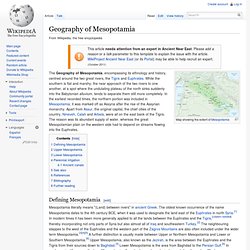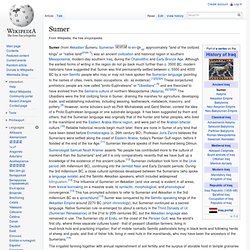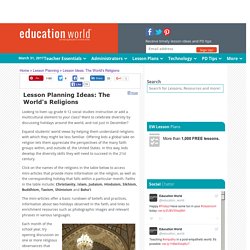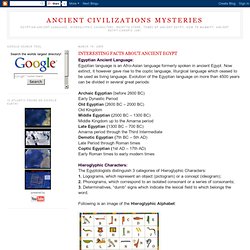

Jackie Brown
Geography of Mesopotamia. The Geography of Mesopotamia, encompassing its ethnology and history, centred around the two great rivers, the Tigris and Euphrates.

While the southern is flat and marshy; the near approach of the two rivers to one another, at a spot where the undulating plateau of the north sinks suddenly into the Babylonian alluvium, tends to separate them still more completely. In the earliest recorded times, the northern portion was included in Mesopotamia; it was marked off as Assyria after the rise of the Assyrian monarchy. Apart from Assur, the original capital, the chief cities of the country, Nineveh, Calah and Arbela, were all on the east bank of the Tigris. The reason was its abundant supply of water, whereas the great Mesopotamian plain on the western side had to depend on streams flowing into the Euphrates. Defining Mesopotamia[edit] Geography of Mesopotamia. Sumer. The irrigated farming together with annual replenishment of soil fertility and the surplus of storable food in temple granaries created by this economy allowed the population of this region to rise to levels never before seen, unlike those found in earlier cultures of shifting cultivators.

This much greater population density in turn created and required an extensive labour force and division of labour with many specialised arts and crafts. At the same time, historic overuse of the irrigated soils led to progressive salinisation, and a Malthusian crisis which led to depopulation of the Sumerian region over time, leading to its progressive eclipse by the Akkadians of middle Mesopotamia. Sumer was also the site of early development of writing, progressing from a stage of proto-writing in the mid 4th millennium BC to writing proper in the 3rd millennium BC (see Jemdet Nasr period).
Origin of name[edit] City-states in Mesopotamia[edit] Top 10 Characteristics Of Effective Vocabulary Instruction. By Kimberly Tyson, Ph.

D. of learningunlimitedllc.com We know that there is a strong relationship between vocabulary and reading comprehension. Systematic vocabulary instruction is an integral part of a K-12 comprehensive literacy framework for instruction. I consider it a privilege to have supported many teachers, coaches, & administrators in building a community that values word learning across classrooms and content areas. Common characteristics of effective vocabulary instruction have been documented in numerous professional journals and books.
History / Social Studies Lessons. Literacy in Social Studies, Science, and Technical Subjects: Scaffolding Levels of Text Complexity (With Discipline-based Texts) Today’s standards in Social Studies, Science, and Technical Subjects require that students comprehend and analyze complex texts and write arguments or informational papers focused on discipline-specific texts.

This one-hour on demand web seminar describes strategies piloted among teams of interdisciplinary teachers, grades 6-12, who implemented reading strategies for complex texts, including primary sources, and facilitated students in conducting research to answer a question, citing evidence to make their claims. Glimpse a few activities that motivated teachers to use geoscience texts that moved from simple graphics (such as a representation of fracking fluids) to a highly scientific article on methane contamination. Discuss the role of a content specialist (geoscientist) in providing context for the readings, understanding the organizational patterns of writing for science, and approaching writing inductively. Expected Outcomes: Five Strategies to Infuse Common Core State Standards with Social Studies Instruction.
Posted by Herff Jones | Nystrom on Friday, June 28, 2013 · 3 Comments The Common Core State Standards are here.

According to the Common Core website, there are only five states that have not yet adopted the new standards. Given the diversity in state educational systems, it is a surprising outcome. Global Connections . Religion. The Islamic tradition recognizes many of the Jewish and Christian prophets, including Abraham, Moses, and Jesus (although he is not considered to be the son of God).

Many non-Muslims mistakenly believe that Muhammad is the equivalent of Jesus in the Islamic tradition; in fact, it is the Quran that stands in the same central position in Islam as Jesus does in Christianity. Muhammad himself is not divine, but a prophet chosen by God to deliver his message and an example of piety to emulate. Quizlet Chrome Add-on. World Religions for Children. Lesson Ideas: The World's Religions. Looking to liven up grade 6-12 social studies instruction or add a multicultural element to your class?

Want to celebrate diversity by discussing holidays around the world, and not just in December? Expand students' world views by helping them understand religions with which they might be less familiar. Ancient Egyptian Cartouche Lesson. INTERESTING FACTS ABOUT ANCIENT EGYPT. The Rosetta stone is a stele fragment from ancient Egyptian origin carrying three versions of the same text, in two languages (old Egyptian and old Greek) and three writing systems (hieroglyphic characters, demotic and Greek).

The Rosetta stone was the key in the deciphering of Egyptian hieroglyphic by Jean-François Champollion in 1822. The Rosetta stone was discovered in the village of Rachid (Rosetta) in July 1799 during the Bonaparte campaign in Egypt. INTERESTING FACTS ABOUT ANCIENT EGYPT. Ancient Civilizations for Kids. Map of ancient civilizations for kids.
Ancient Civilizations. Ancient Civilizations. History for Kids: Ancient Mesopotamia. Ancient Mesopotamia refers to the place where humans first formed civilizations.

It was here that people first gathered in large cities, learned to write, and created governments. For this reason Mesopotamia is often called the "Cradle of Civilization". Map of Mesopotamia by Atanas Kostovski Geography. Social Studies. 6th grade. Ancient Egypt 3150-332 BC. Mesopotamian Civilizations 6000-550 BC. Mesopotamia. The Egyptians. Ancient Civilizations. The history of civilization is a long one.

This sites take you way back into history to see human civilization as it first looked. Ancient Civilizations in General Ancient civilizations arose all over the world. Find out about these cultures and their peoples in a survey of history from "way back when. " Ancient Egypt. Ancient China. Ancient India. Ancient Civilization. SchoolTube. Educational Videos, Teaching Resources, Education Tools. TeacherTube - Teach the World. Free Educational Videos for K-12 Students.